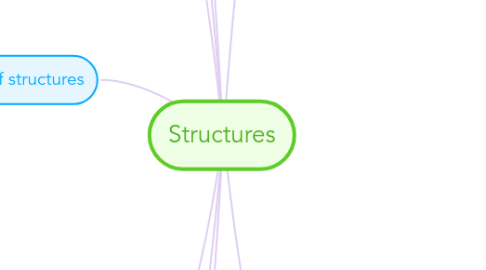
1. What is structures
1.1. A system made up of members work together to withstand loads and forces.
1.2. Why Fail?
1.2.1. Poor selection of materials.
1.2.2. Fatigue resulting from the changes in the properties of materials over time.
1.2.3. Lack of understanding of forces involved in the design.
1.2.4. Excessive loads.
2. What structures does?
2.1. Resist force
2.2. Support Load
2.3. Hold parts together in the right place
3. Functions of structures
3.1. Span
3.1.1. To stretch across two points for access.
3.2. Protect
3.2.1. To prevent contents from damage.
3.3. Contain
3.3.1. To hold within itself the content(s) of the object.
3.4. Support
3.4.1. To carry the weight of the object.
4. Types of structures
4.1. Man-made
4.1.1. Frame
4.1.1.1. Ladder
4.1.1.2. Scaffoldings
4.1.2. Shell
4.1.2.1. Chassis of car
4.1.2.2. Helmet
4.1.3. Both
4.1.3.1. Chair
4.1.3.2. Bus stop shelter
4.2. Natural
4.2.1. Frame
4.2.1.1. Tree branches
4.2.1.2. Skeleton
4.2.2. Shell
4.2.2.1. Snail shell
4.2.2.2. Nuts shell
4.2.3. Both
4.2.3.1. Human
4.3. Shell
4.3.1. The skin itself provides strength and rigidity.
4.3.2. Made up of joining a number of members together, gain strength by how the members are joined and arranged.
5. Types of load
5.1. Dynamic
5.1.1. Changes size, position or direction.
5.1.2. More force than static.
5.2. Static
5.2.1. Has constant size, position and direction of force within a structure.
5.2.2. Less force than dynamic.
6. Material properties
6.1. Strength
6.1.1. Ability to resist force without breaking.
6.2. Hardness
6.2.1. Ability to resist cutting, scratching or wearing off.
6.3. Toughness
6.3.1. Ability to withstand an impact without breaking.
6.4. Elasticity
6.4.1. Ability to return to its original shape after deformed.
6.5. Stiffness
6.5.1. Ability to resist bending and twisting.
7. Forces on structures
7.1. Bending force
7.1.1. Stretching and pressing
7.1.1.1. Table top
7.1.1.2. Fishing rod
7.2. Shearing force
7.2.1. Sliding
7.2.1.1. Hinge pin of a pair of pliers.
7.2.1.2. Blades of scissors
7.3. Tensile force
7.3.1. Pulling, stretching
7.3.1.1. Fishing line
7.3.1.2. Lift cable
7.4. Torsion force
7.4.1. Twisting, turning
8. Members of structure
8.1. Beam
8.1.1. Simply supported beam
8.1.1.1. Widest section taking the load to achieve maximum strength
8.1.2. Cantilever beam
8.1.2.1. is supported at one end.
8.1.2.1.1. Balconies
8.1.2.1.2. Shopping carts
8.1.2.1.3. Cranes
8.1.2.1.4. Air-craft wings
8.1.2.2. Used where it is only possible to support at one end or where it is necessary to keep a large gap clear.
8.1.3. Commonly made of steel.
8.1.4. Resist bending force from load.
8.1.4.1. 'I' Section - Stiffest section against bending
8.1.5. Vertical Beams
8.1.5.1. Columns
8.1.5.1.1. Support the weight directly on top.
8.1.5.1.2. E.g. Support roofs of building
8.2. Braces
8.2.1. Diagonal elements
8.2.2. Provided good support to prevent bending.
8.2.3. E.g. Shade port , Roof
8.3. Strut
8.3.1. Resist load by pushing outwards against it.
8.3.2. A member in a framework that is in compression.
8.4. Tie
8.4.1. Resist loads by pulling inwards against it
8.4.2. A member in a framework that is in tension.
8.4.3. Not stiff enough => distort
8.4.4. Too Weak => snap
9. Reinforcement
9.1. WHY Reinforcement
9.1.1. To increase rigidity and stiffness
9.1.2. To spread the load.
9.1.3. To reduce stress concentration.
9.2. Frame
9.2.1. Gusset plates
9.2.1.1. To increase the effective area of the joint.
9.2.1.2. Stress distribution
9.2.1.3. Advantages
9.2.1.3.1. Quick and easy construction
9.2.1.3.2. Can make changes to structure easily compared to adhesives.
9.2.1.3.3. Plates prevent the joints from twisting.
9.2.2. Brace
9.2.2.1. Diagonal element to strengthen framework
9.2.3. Triangulation
9.2.3.1. One of strongest shape
9.2.3.2. Achieve stiffness in framework
9.2.3.3. E.g. bicycle frame, truss bridge
9.2.3.4. Most of structural strength provided by the member. The joints cannot be twisted without one of the members being either stretched or bend.
9.3. Shell
9.3.1. Folding
9.3.1.1. Add thickness to the side to stiffen the structures
9.3.2. Ribs
9.3.2.1. Folds to stiffen and strengthen the sides of the shell structures.
9.3.2.1.1. Prevent the sides from caving in.
9.3.2.2. E.g. Egg tray, Plastic cup.
9.3.3. Curves
9.3.3.1. Reduce stress concentration.
9.3.4. Corrugations
9.3.4.1. Folds to stiffen flat structures
9.3.4.2. To absorb shock for packaging.
9.3.4.3. E.g. Carton box
9.3.5. Honeycomb
9.3.5.1. Hollow core structure to reduce weight
9.3.5.2. Stiffen flat construction
9.3.5.3. E.g. Doors
9.3.6. Web
9.3.6.1. Triangular flaps used at the corners of structure to reduce shear or resist bending of corners.
9.3.6.2. E.g. Corners of plastic files.
9.3.7. Laminating
9.3.7.1. Layers of materials are glued together to create a thicker material.
9.3.7.2. E.g. Plywood sheets
9.3.7.2.1. Laminated at right angle to each layer to make it strong in all directions.
